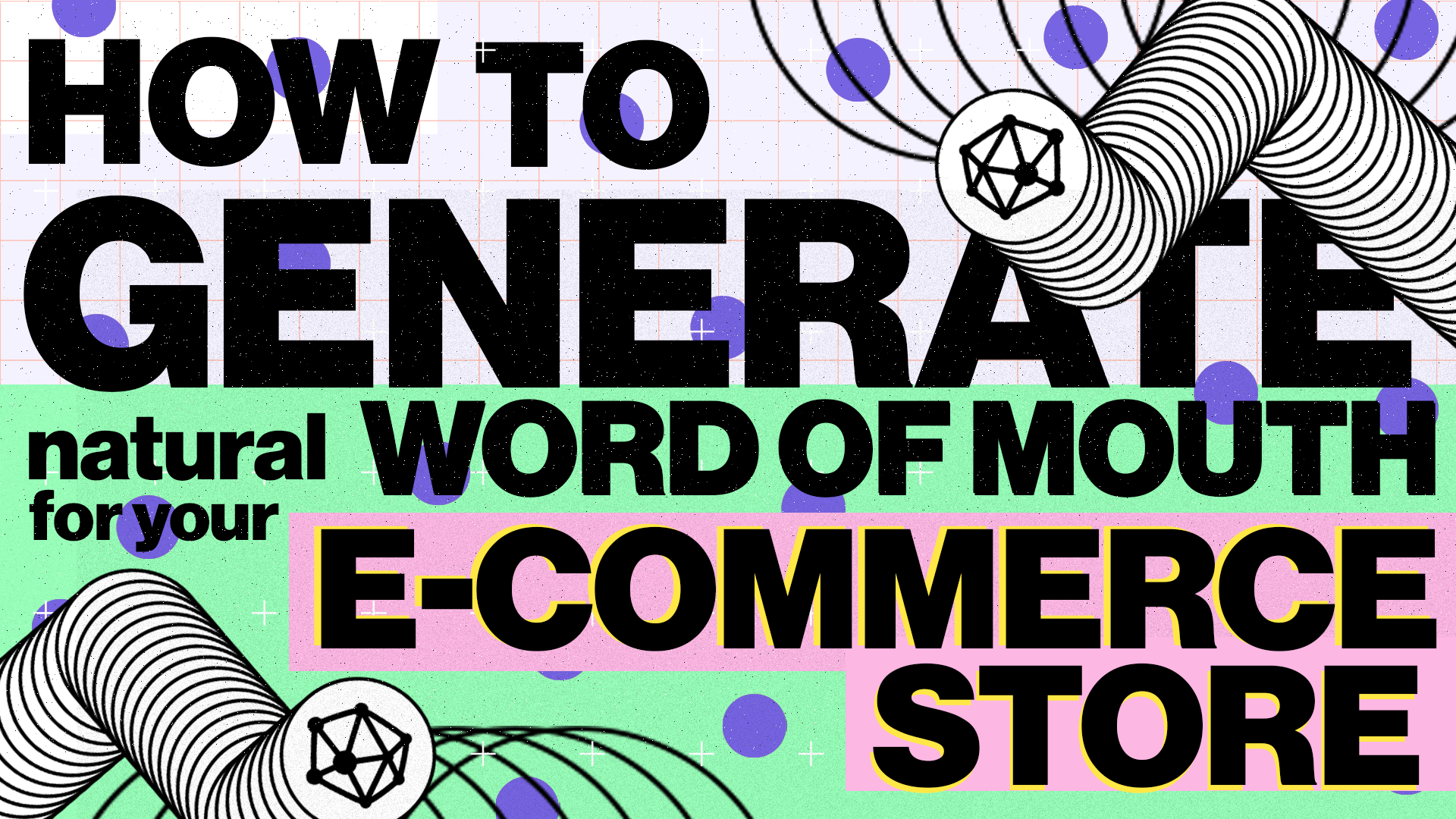When you’re in the e-commerce industry, you’ll know that everyone is vying for attention. It’s like being at a party where everyone’s shouting over the music to be heard.
So you’ll think, “How do I make my mark? How can I stand out from the others?”
But what if I told you there’s a way to make people naturally chat about your store without you having to scream your lungs out?
The answer lies in the conversations people have about your brand. Yep, generating natural word of mouth (WOM) is the golden ticket here. It’s personal and trustworthy—that’s why it’s undeniably effective.
You see when a satisfied customer talks about their positive experience with a friend or a family member, it’s not just a recommendation. It’s a personal endorsement that carries weight.
As an e-commerce store owner, you want your customers to feel connected to your brand so that they’ll feel confident in their purchases, which will make them suggest your product to others.
In a research done by the University of Maryland, more than half of surveyed marketers believe and agree that WOM is the most effective form of marketing. In reality, though, only 6% claim to use it effectively.
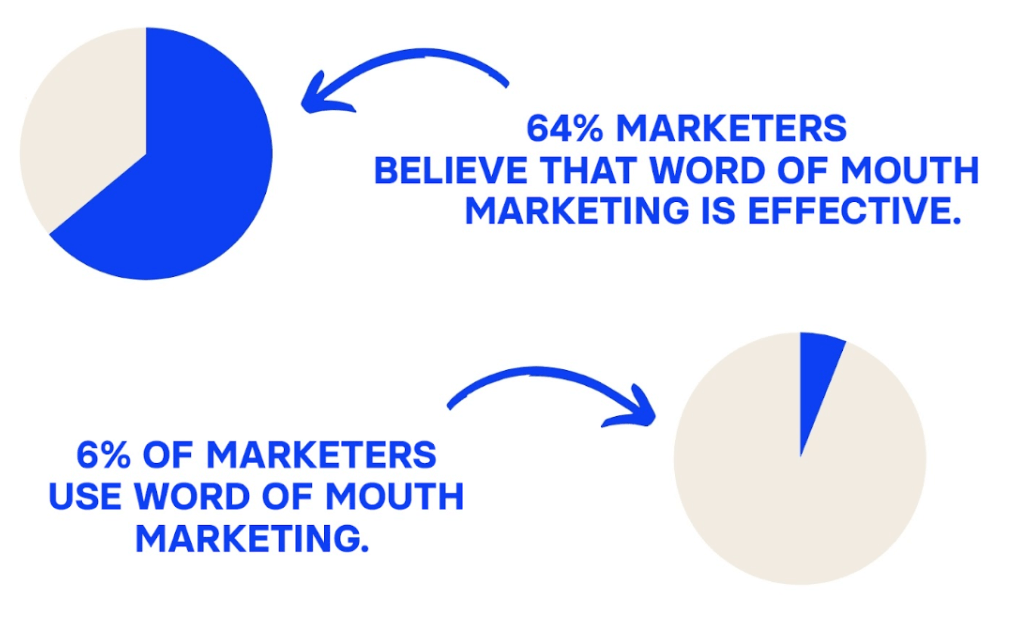
So, the question is, how can you tap into this powerful and tricky marketing strategy?
What steps can you take to encourage your customers to talk about your product? What can push them to willingly spread the word about your e-commerce business?
We’re here to answer your questions, and more.
What is Word-of-Mouth Marketing in E-Commerce?
Word-of-mouth marketing (WOMM) is the process of influencing and encouraging natural conversations about your products or services.
In the context of e-commerce, it refers to the positive discussions that your customers have about your online store. These conversations can happen anywhere—from social media platforms to online forums, review websites, and even in-person gatherings.
As mentioned above, WOM is all about getting your customers to become your brand advocates.
However, it is often overlooked when developing strategies for any e-commerce business. There’s this thinking that WOM takes time to be fruitful, and you don’t have that much time when you’re in e-commerce.
We beg to disagree, though! While it doesn’t have a quick turnaround like paid ads do, the returns are high and last a long while—even a lifetime!
It also doesn’t take too much of an effort—you can do it side by side with your regular operations.
Natural vs. Incentivized Word-of-Mouth
There are two main types of Word-Of-Mouth: organic and incentivized. In order to use it effectively, you first need to understand the differences between the two and how each works.
Natural Word-of-Mouth
Let’s dive into the world of natural WOM—no, we’re not talking about overpriced veggies here.
Natural word-of-mouth (a.k.a. organic word of mouth) is the magic that happens naturally when your customers are so thrilled about your products or services that they can’t help but shout about it from the rooftops (or maybe just tweet about it, but you get the picture).
This type of WOM doesn’t rely on bribes or special incentives; it’s 100% genuine and authentic. Customers share their thoughts simply because they believe in what you’re offering, and guess what? That kind of passion is contagious in the e-commerce world.
It’s the type of word-of-mouth that doesn’t rely on any prodding from you.
Incentivized WOM
On the other side of the coin is the incentivized WOM. This involves giving your customers a little nudge to share their experiences. This could be in the form of discounts, freebies, loyalty points, or rewards.
For example, you might offer a discount to a customer if they successfully refer a friend to your store. It’s like giving a small treat or incentive to start the conversation.
For this to work, a complete referral program is required. Learn about how to set up a referral program 5 steps if you’re not yet familiar with it.
Keep in mind that, yes, it’s effective, but it’s more important to make sure that your incentives don’t overshadow the authenticity of their recommendations.
Whether organic or incentivized, WOM is incredibly valuable for e-commerce. It builds trust, enhances customer loyalty, and drives high-quality traffic to your site. In this article, we’ll focus more on how to do it naturally, which is just one part of your overall referral marketing plan.
Benefits of Natural Word-of-Mouth
But why exactly should you put an effort into generating natural word-of-mouth instead of just relying on incentivized word-of-mouth?
It’s because when it comes to e-commerce, only a few marketing strategies can rival the effectiveness of natural WOM. Here are some of the reasons why:
Cost-Effective
One of the biggest advantages of natural WOM is that it doesn’t require a huge marketing budget. Unlike paid advertisements (which can quickly drain your resources), this one relies on your customers’ genuine enthusiasm.
It is getting free advertising from people who actually used and loved your products. This means you can allocate your budget to other parts of your business while still reaping the benefits of increased brand exposure and awareness.
Credibility
Natural WOM has an advantage and unique attribute compared to any form of marketing—trust and authenticity. Thus, it carries a level of credibility that no paid promotion can ever match.
According to the 2023 Edelman’s Trust Barometer Special Report, 59% of consumers are more likely to buy new products when they trust the brand, regardless of price.
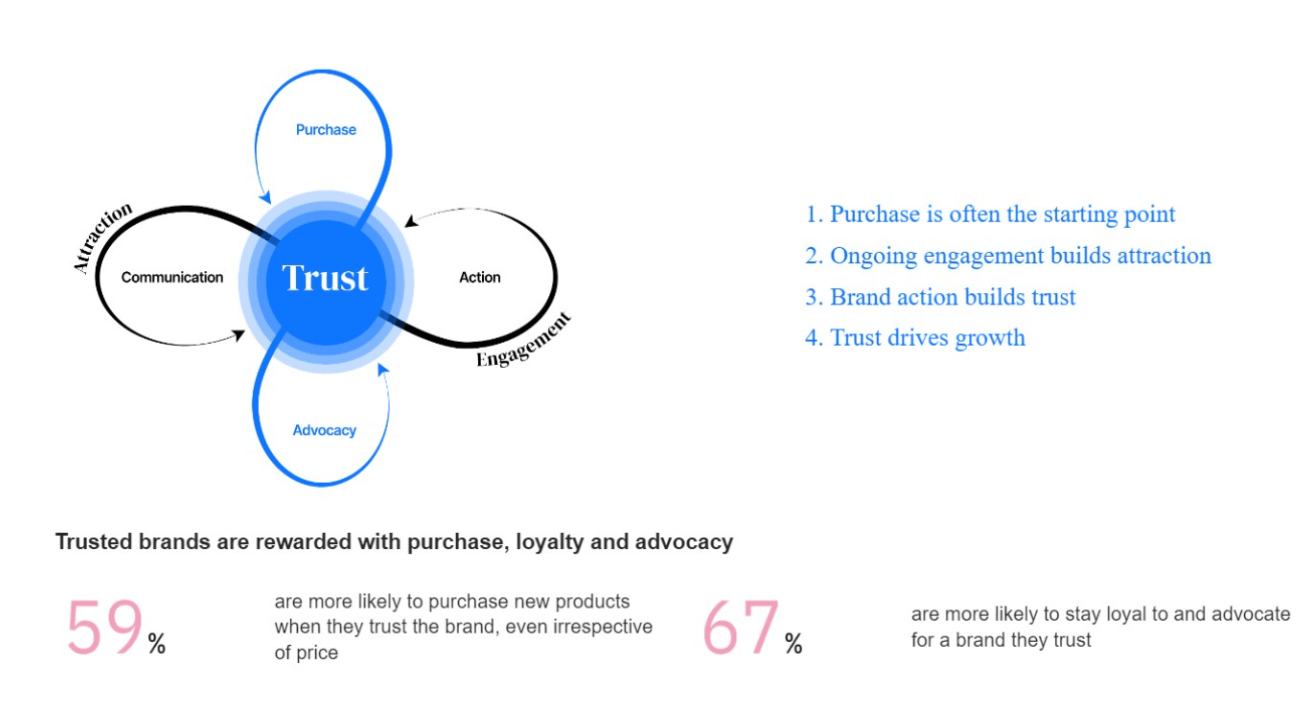
This trust translates, of course, into a higher conversion rate and stronger customer loyalty.
Unlike paid ads (which some customers or audiences might view with skepticism), suggestions or recommendations from friends and family are perceived as unbiased and reliable.
According to marketing expert Jay Baer, we (people) trust friends and strangers more than we trust brands. The simple reason is that we know they have no ulterior motive other than to share their experience, whether they be good or bad.
Think about it. When we see an ad about a product, we don’t automatically jump to a purchase decision, right? We research the product and check the reviews first. Oftentimes, the seller would have to push us toward the next phase of the marketing funnel before we get to the finish line (actual sale).
With word-of-mouth marketing, the whole funnel is skipped. From step 1 (brand or product awareness), we immediately jump to step 4 (purchase).
Increased Sales
Now, let’s dive into the good stuff—how word-of-mouth can skyrocket your sales and make your online store as famous as the latest viral meme. Every time a happy customer brags about your product to their friends, it’s like a free mini-commercial that hits potential buyers who already trust the source.
Those recommendations cut through the noise and skepticism of traditional advertising, making new customers more likely to hit that “Buy Now” button.
In the cutthroat world of e-commerce, where customers have endless options at their fingertips, a nudge from a friend’s glowing review can be the tipping point for a purchase. And the best part? This ripple effect of trust-driven sales keeps spreading, turning your satisfied customers into an unstoppable, organic sales force.
Enhanced Brand Loyalty
Natural WOM isn’t just about getting new customers; it’s also about creating repeat customers who’ll stick with you like glue.
When people share their positive experiences, it fosters a community of loyalists who feel connected not just to your products but to your brand’s ethos. These customers are more likely to come back for more and even defend your brand if a storm brews on social media. Think of them as your unofficial cheerleaders, always rooting for you from the sidelines.
Through genuine, heartfelt recommendations, the ripple effect of organic WOM can seriously snowball, turning happy customers into an army of brand advocates. So, bear this in mind the next time you wonder if it’s worth going the extra mile to wow your customers—it totally is!
9 Ways to Generate Natural Word-of-Mouth for Your E-Commerce Business
It’s time to get into the meat of this article: generating natural word-of-mouth for your biz. Gaining traction around your e-commerce store requires you to develop and exert strategic efforts that resonate with your audience and reflect your brand ethos.
Here’s how to do that:
1. Provide Exceptional Customer Service
An on-point and satisfying customer service is the start of having positive WOM. Happy customers are your best advocates, and their authentic reviews can do wonders for your brand.
How to do it? It’s simple.
- Provide Quick Response Times.
Customers hate waiting!
Make sure that your customer service team responds to queries promptly, ideally within a few minutes. To maintain your channels, you can use an automated chatbot to handle initial queries. AI chatbots are everywhere nowadays, and they’re pretty affordable, too.
Create a list of the most common questions so your chatbot can provide a ready-made answer.
If the request or inquiry requires a human touch or the issues are complex, make sure to direct your customers to human agents immediately.
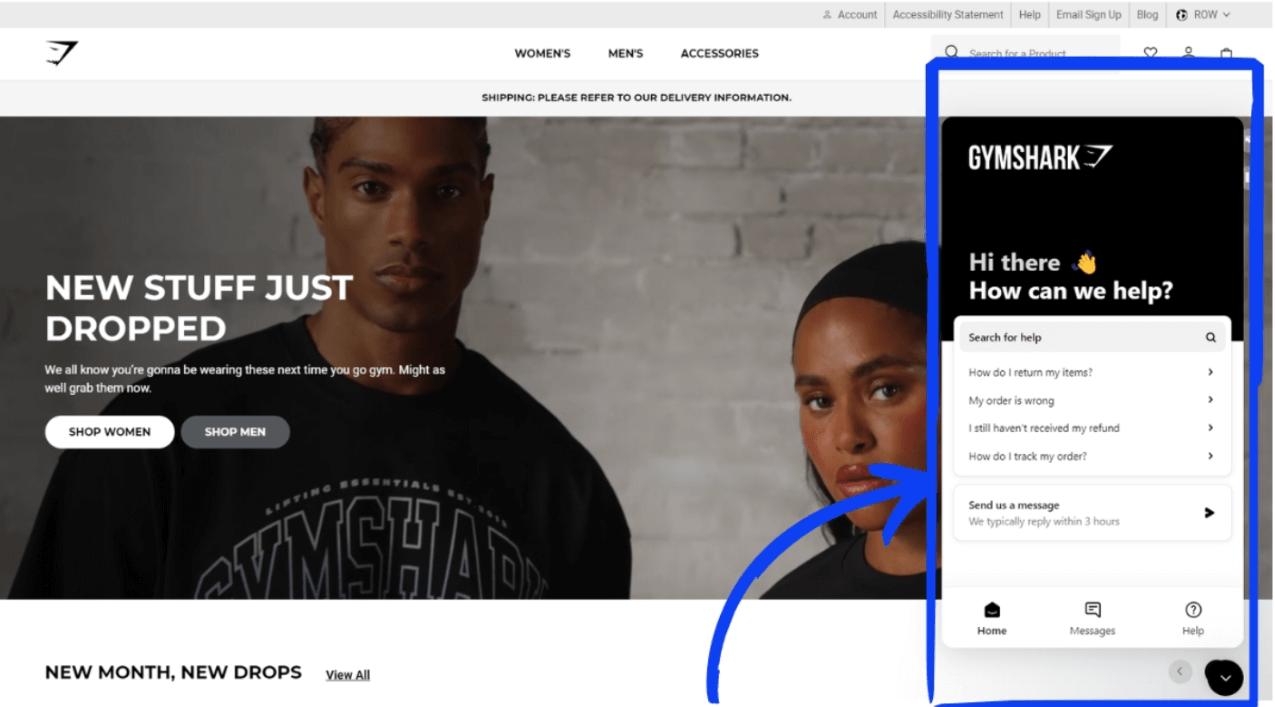
- All Interactions Must Be Friendly.
Just being quick won’t cut it—you need to be friendly, too. Train your customer service team to not just resolve queries, but to do so with a smile. A positive interaction can turn a disgruntled customer into a loyal one, and they’re more likely to sing your praises to others.
Chats may sometimes sound cold and a smile cannot be seen, so make sure to teach your team how to show genuine friendliness with the proper choice of words.
- Personalize the Experience.
Don’t treat your customers like numbers. Use their names, remember their past purchases, and tailor your interactions based on their needs and preferences. Personalization makes customers feel valued and appreciated, leading to a more memorable and positive experience.
- Go the Extra Mile.
Surprise your customers with little extras that they didn’t expect. This could be anything from a handwritten thank-you note in their order to an unexpected discount voucher. Small gestures like these create big impacts and give customers something to talk about.
2. Encourage User-Generated Content
User-generated content (UGC) is a goldmine for natural word-of-mouth. When customers post photos, reviews, or videos of your products on social media, it provides social proof and encourages others to trust and purchase from your brand.
How to foster UGC:
- Host Contests and Giveaways.
Encourage customers to share their experiences online by offering incentives. Host photo contests where customers share pictures of their purchases using a specific hashtag or set up giveaways where participants need to post about their favorite products to enter.
- Showcase Customer Stories.
Feature your customers’ reviews, photos, or testimonials on your website and social media platforms. This not only provides social proof but also makes your customers feel special and appreciated, encouraging more UGC.
Glossier did the exact thing by focusing on the stories their customers share.
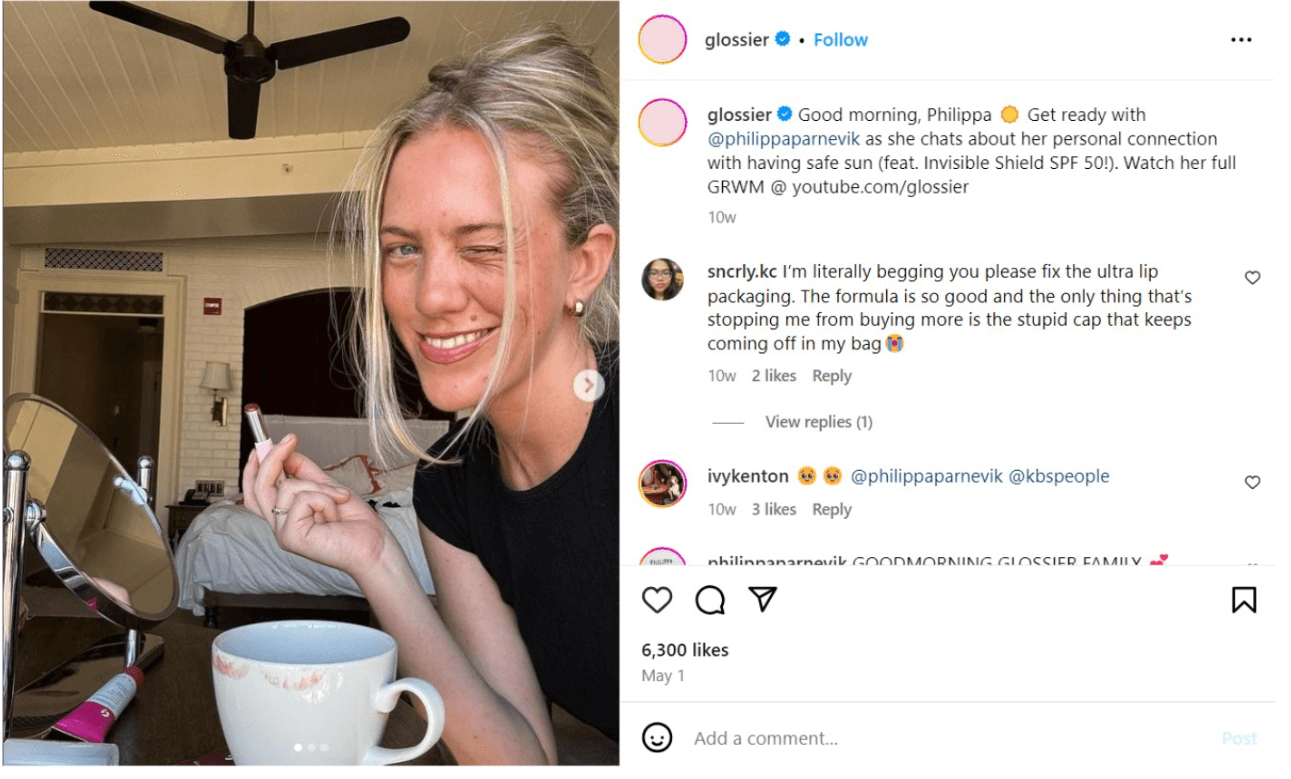
- Run Social Media Campaigns.
Create branded hashtags and run contests to motivate your customers to post about your products. Prepare incentives like discounts or freebies for the best posts. This creates buzz and encourages UGC.
- Send Follow Up Emails.
After a customer makes a purchase, send them an email thanking them for their support and asking if they’d like to share their experience on social media. This gentle reminder can lead to more UGC.
Feature these UGCs on your website and social media to build trust and credibility for potential customers. When they see real people enjoying your products, they’re more likely to make a purchase.
3. Leverage Influencer Partnerships
Influencer marketing is a form of WOM where you collaborate with key individuals who have a strong following. Influencers are a dime a dozen nowadays, so finding one that matches your needs is not that hard. An endorsement from an influencer can significantly boost your brand’s visibility and credibility.
Here’s how you can do it:
- Choose the Right Influencers.
Look for influencers whose followers align with your target market. The influencer doesn’t have to have millions of followers; sometimes, micro-influencers with highly engaged audiences can be even more effective.
- Build Authentic Relationships.
Approach influencers with genuine interest and offer something valuable in return. This could be in the form of free products, exclusive discounts for their followers, or even a paid partnership if your budget allows.
- Encourage Honest Reviews.
Rather than scripting what influencers should say, encourage them to share their honest opinions. Authenticity is key in influencer marketing, and their genuine endorsement will carry more weight with their followers.
HubSpot has a pretty good guide on Influencer Marketing, which we recommend you check out if you want to use influencers for expanding your brand and product awareness.
Authenticity is crucial. Customers are smart. They can tell when a promotion feels forced or fake, so make sure that the partnership or endorsement fits with the influencer’s usual content.
4. Make the Package Unboxing a Delightful Experience
If you’re not in the know yet, I will let you in on one of the biggest trends today—unboxing. Customers have made it a point to take videos of their unboxing of products ordered online for the whole internet to see.
Unboxing, or the act of opening packages, is part of the customer experience nowadays. It’s so important that companies have built services and products around unboxing! Take a look at this boxing/unboxing video from Love Day Social:
If you pack your e-commerce products poorly, you can expect to see a frown on your customers’ faces. So, take some time to create a package that’s aesthetically pleasing and easy to open.
It’s really easy. All you’ve got to do is:
- Create Aesthetic Packaging.
Use high-quality packaging materials and make sure they are sturdy enough to protect your products during shipping. You can also add personal touches like handwritten thank-you notes or branded stickers for an added touch.
You can take it a step further by making sure the entire package looks like a gift waiting to be opened by a customer. After all, they purchased from you as a gift from themselves, right?
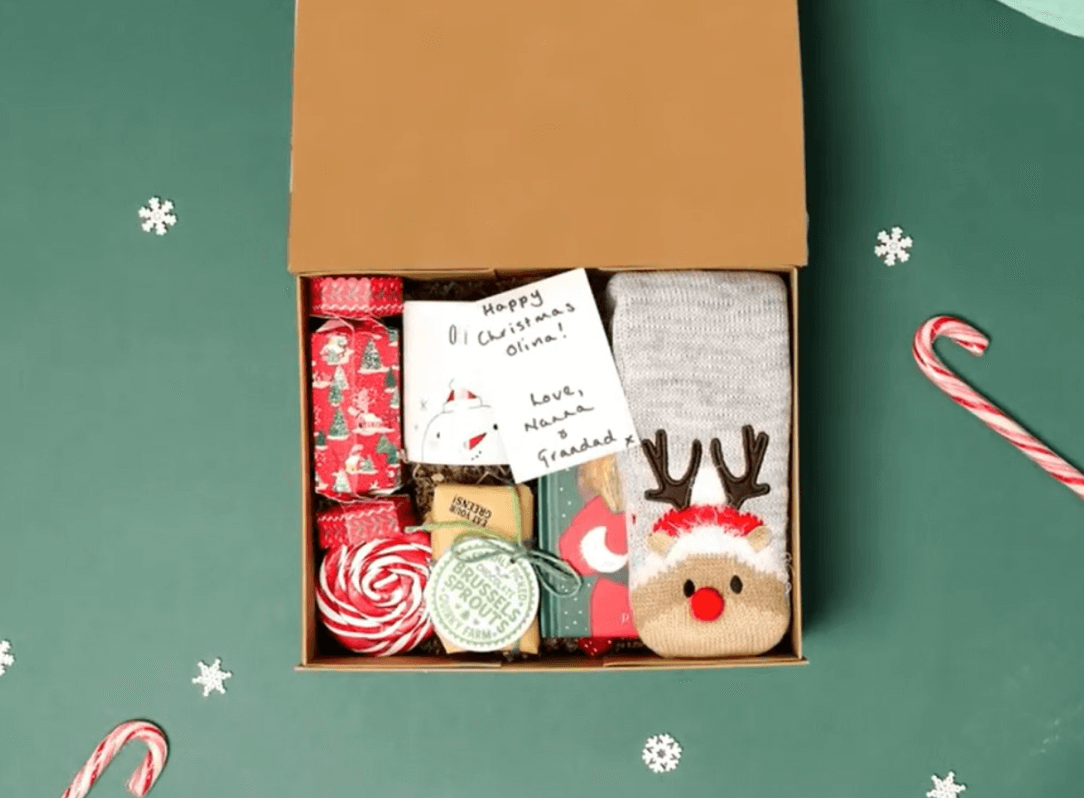
- Include Free Samples or Gifts.
Customers love freebies, no matter how small. Consider including a little something extra in their packages as a surprise and delight tactic. This not only makes them feel appreciated but also encourages them to share their excitement with others through word-of-mouth.
5. Provide Shareable Moments
Create moments or experiences that your customers will want to share with their networks. Make them happy and keep them engaged with some perks or events.
- Limited-Time Discounts
Offer exclusive deals and flash sales that compel your customers to talk more about your brand and check out the products they’ve kept in the cart for a long time.
- Giveaways
Host contests or raffle draws with appealing prizes to encourage participation and sharing. Make sure the entry process is simple and the prizes are desirable and suitable for your target market.
The key is to create content that’s both engaging and share-worthy. Think of memorable experiences your customers will be excited about, eye-catching promotions, or even fun behind-the-scene sneak peeks of your brand.
6. Foster a Community Around Your Brand
Building a community around your brand is an effective way to encourage word-of-mouth marketing. When customers feel like they are part of something, they become more invested in your brand and are more likely to recommend it to others.
Here’s how you can build a community:
- Provide A Space for Communication.
Create a Facebook group or an online forum where customers can interact with each other and with your brand. This allows them to share their experiences, ask questions, and bond over their love for your products.
Share exclusive content to stir up excitement and exclusivity!
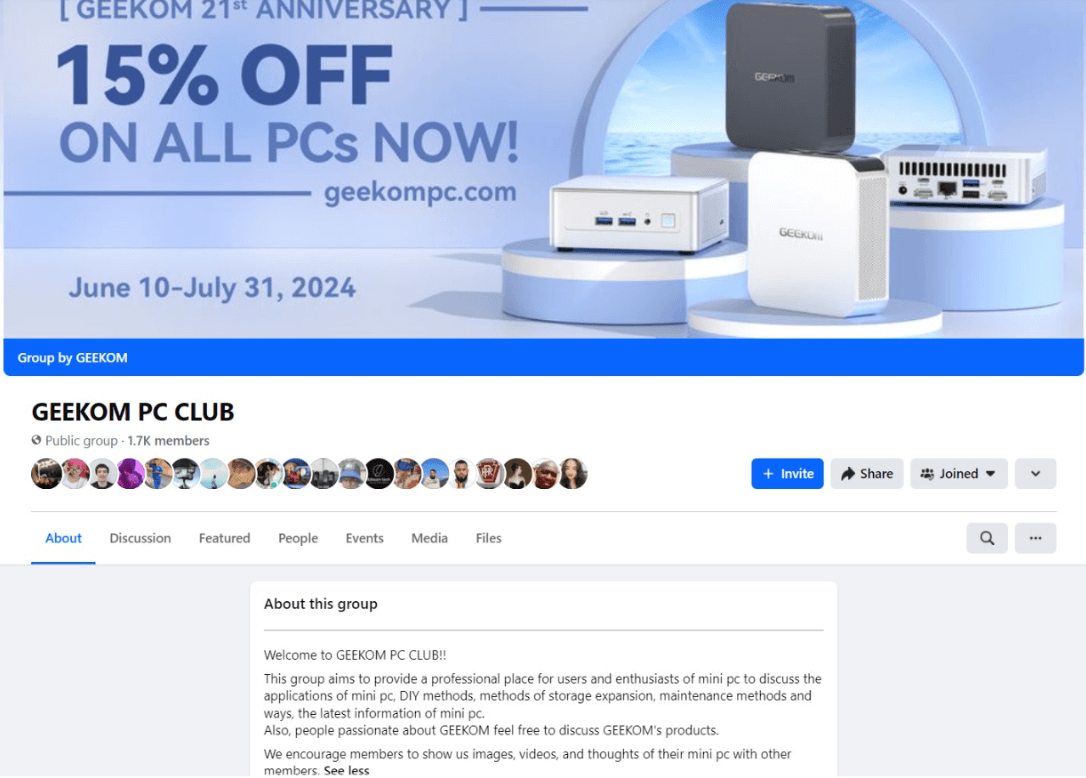
- Organize Events or Meetups.
Host events or meetups where your customers can come together and
Building a loyal community can further amplify your WOM’s impact. Once it’s built, you have to nurture it. Here’s what you can do.
- Host Special Events.
Host virtual or in-person events to connect with your audience. Do product launches, Q&A sessions, and live demonstrations. Make your customers feel like a part of a huge (but exclusive) club.
- Loyalty Programs
Make a loyalty program that will reward your most dedicated customers. Those part of the program can be given discounts, early access to new products, beta testing, and special gifts. Reward them so they’ll encourage others to do and get the same perks as well.
Remember: making them happy enough to share with others is the key to word of mouth!
A strong community naturally creates a sense of belonging within members, which encourages them to promote your brand. Successful communities become willing advocates for your brand, spreading positive WOM far and wide.
7. Leverage Customer Reviews and Testimonials
Customer reviews and testimonials are the goldmines for further generating good WOM. You need to actively seek and then showcase these reviews to significantly improve your brand reputation. Why? Because these reviews can show how people find value in your product.
- Request Reviews
After every successful purchase, you can send a follow-up email asking your customers to leave a review. Encourage them to add photos or videos of the product, and how they find it.
You can use tags to identify which aspect of the product the review focuses on, whether it’s the color, texture, scent, packaging, and others that are applicable. Make sure to simplify the process by providing direct links to your review platform.
- Offer Incentives
Motivate more customers to share their experiences by offering small rewards, discounts, or vouchers for leaving reviews.
- Feature Positive Reviews
Highlight them everywhere. But don’t be redundant, avoid using the same review for everything. Display your good reviews on your product pages, website homepage, and other marketing content. You can also post them on social media to gain more social proof and build trust.
- Address Negative Reviews
Respond to negative feedback just like how you will respond to a positive one. Be professional and thank them for being genuine. Show potential customers that you care about their experiences and are committed to resolving issues. After all, you can use it as an opportunity to improve your product.
Examples of E-Commerce Stores that Successfully Used Word-of-Mouth Marketing
1. Fashion Nova
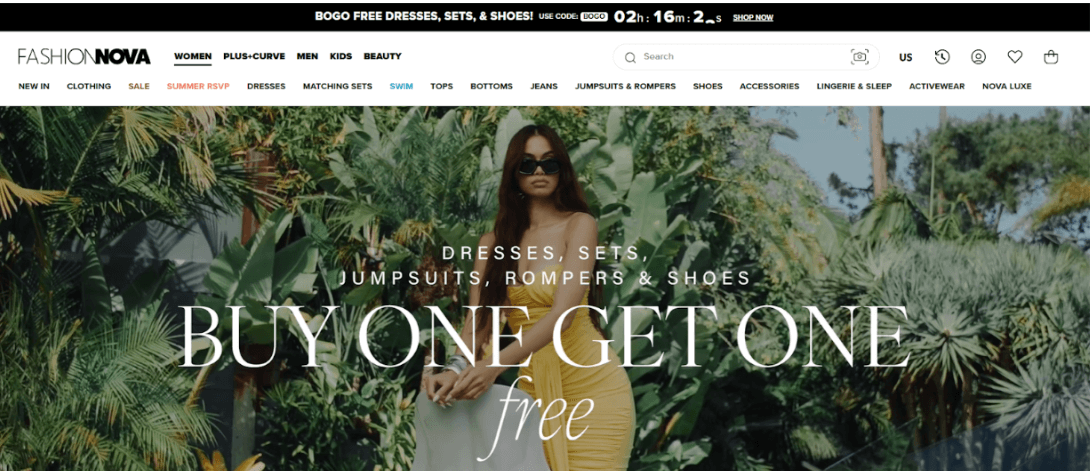
Founded in 2006 by Richard Saghian, Fashion Nova has become a leading fashion retailer known for its trendy, fashionable, and affordable pieces.
They have used word-of-mouth marketing by harnessing the power of TikTok —partnering with influencers and even celebrities to showcase their clothes in everyday settings.
It made their brand relatable and appeared reachable to people. If you have a startup clothing line, you can do this too! You can collaborate with mini-influencers to start and encourage your customers to post UGCs.
Considering TikTok’s booming reach and algorithm, just imagine the reach you can potentially achieve. This approach creates a continuous viral loop of organic promotion and brand advocacy.
2. Gymshark
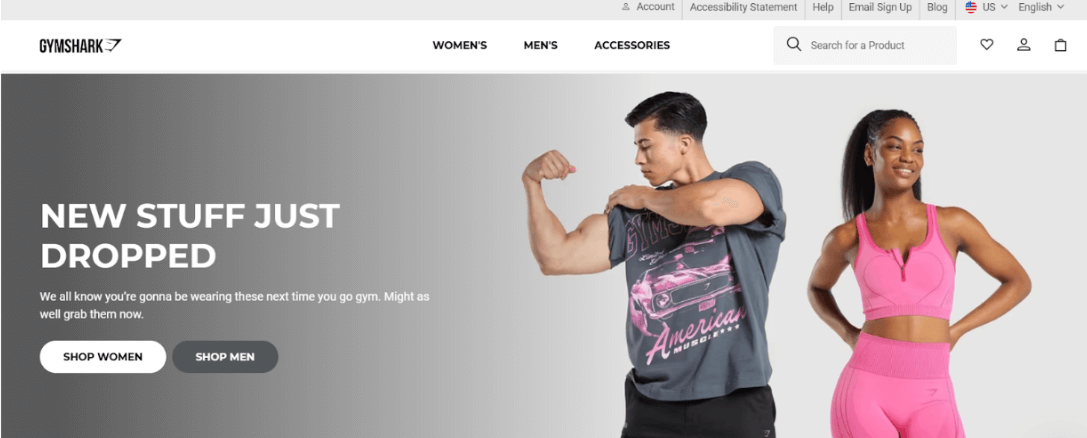
Gymshark started in 2012 as a supplement-selling business before transitioning to selling activewear. They capitalized on social media and asked their users to post workout videos and transformations while wearing Gymshark gear.
They often feature these videos on their social media accounts. This strategy created a sense of community for their customers and encouraged more participation. This, in turn, convinced more people around their users to join the bandwagon of using Gymshark workout clothes.
You can emulate this practice if you depend on social media for your marketing efforts. To ensure that you track the traction you’re getting, you can use branded hashtags.
You may offer incentives like discounts or features on your social media pages to further motivate participation. UGC acts as social proof, building trust and encouraging others to try your products.
3. The Ordinary
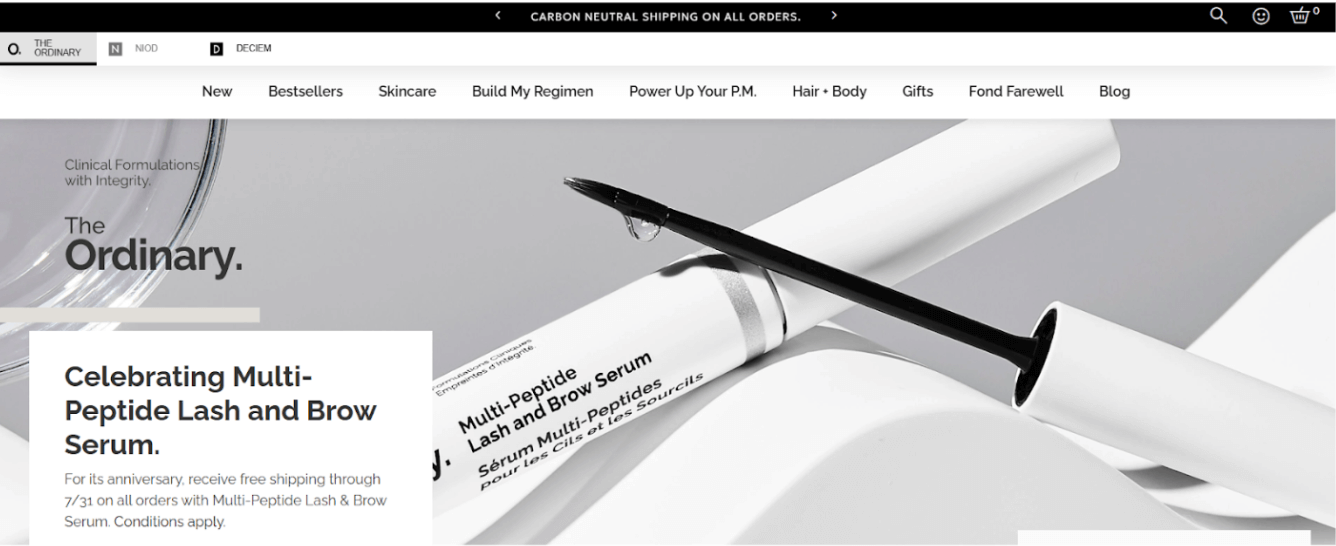
Deciem launched The Ordinary in 2013, offering skincare products focusing on transparency and affordability.
Despite it being launched nearly a decade ago (as of writing), it only experienced a surge in popularity on Tiktok as its customers and users began sharing their skincare routines and how using The Ordinary resulted for them.
This type of authentic content led to a widespread, viral word-of-mouth effect, leading users to educate each other about their products’ benefits and how to integrate them into different skincare regimes.
4. Rare Beauty
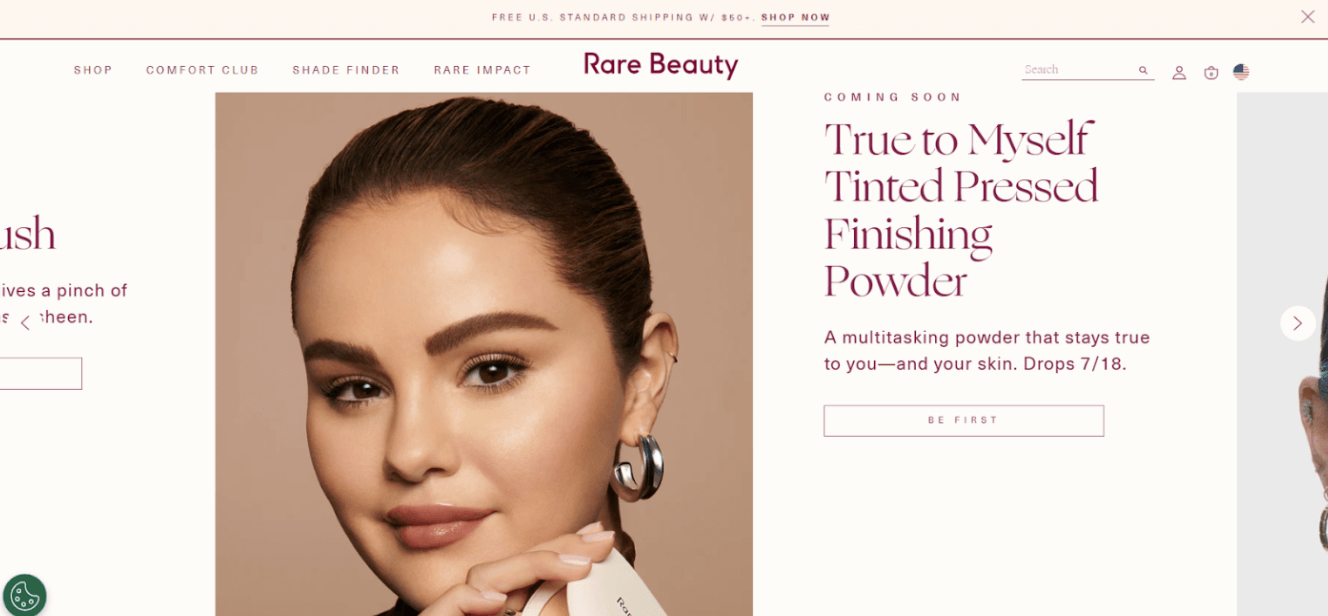
Aiming to promote self-acceptance and natural beauty, Selena Gomez launched Rare Beauty in 2020. Ever since then, her team has leveraged social media and encouraged customers to share their looks and makeup tutorials.
The brand’s messaging around mental health and self-love resonates deeply, especially with TikTok’s young audiences, who in turn create and share content that further amplifies these values.
They also collaborated on high-profile projects, and user-generated content significantly boosted the brand’s visibility and credibility.
5. Drunk Elephant
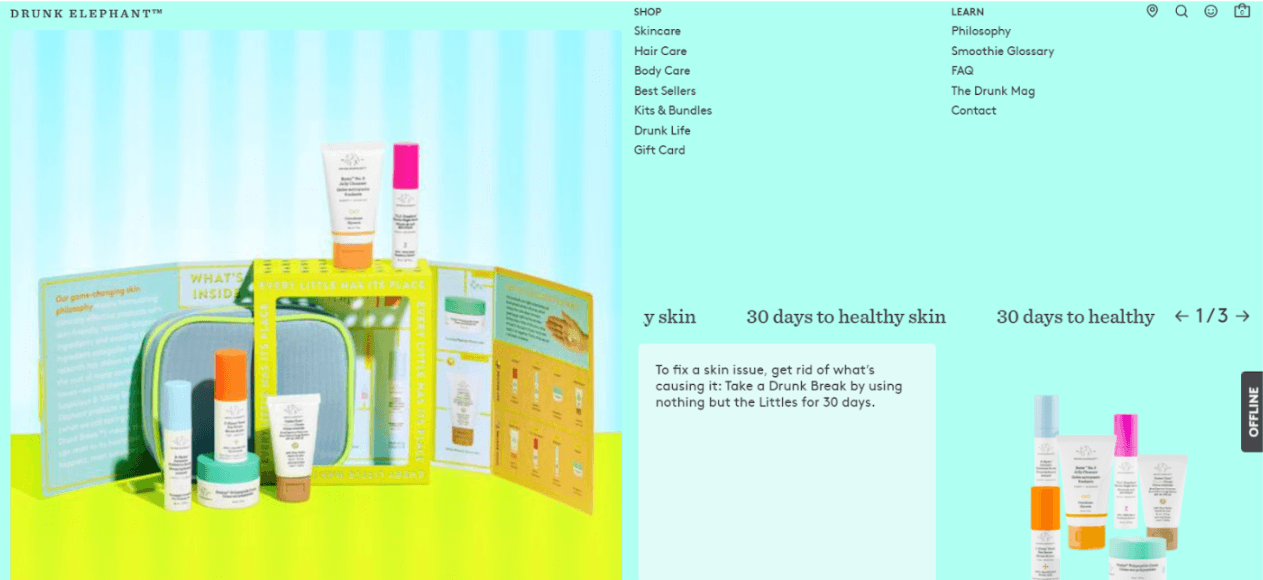
Drunk Elephant is a skincare brand known for its focus on non-toxic ingredients, launched in 2012.
And how did they use word-of-mouth marketing? Their success can be attributed to the engaging and educational content produced by their users.
They encourage them to post their skincare routines and results, and Drunk Elephant reposts them on their own social media pages. This improved brand awareness and built trust by showing real-life testimonials, attracting potential customers.
Key Takeaways From These Examples
If you have a startup brand and you’re trying to reach new customers by generating natural word-of-mouth, then we can get a few takeaways from the brands above.
Focus on Authenticity and Transparency
The Ordinary’s climb to success is based on their customers’ genuine routines and results. Who doesn’t love truthfulness?
You may emulate this approach by highlighting the real benefits and being transparent about the ingredients or parts of your product.
If you sell food and claim it’s vegan, it better be true. You’ll build trust and loyalty if your customers find you authentic and honest.
When customers see real results from real people, they are more likely to believe in and try the products themselves.
Promote Community and Engagement
All of the brands mentioned above have built a sense of community by doing various campaigns on their social media and even in person.
Of course, they have a budget,” you might say.
But you can do some tricks to get the same results still. You can foster a community around your brand by engaging with your customers’ content, hosting live Q&A sessions (maybe on Facebook or Instagram), and creating interactive content like challenges on TikTok.
A strong community can only benefit you. It increases customer loyalty and encourages word-of-mouth promotion, as customers feel a part of something bigger.
Align with Social Values
If you’re offering products that support a cause, highlight them in your marketing efforts. Rare Beauty did this, raising its message of self-acceptance and mental health.
You may align your brand with social causes and values that will resonate with your target audience and customers. Share stories and content that reflect these values.
Customers who connect with your brand on a deeper, value-based, personal level are more likely to share and promote your products.
Brands that craft unforgettable, share-worthy experiences? They’re the ones killing it in today’s cutthroat market.
E-commerce businesses are always up to something new, finding fresh ways to connect with their crowd. And guess what? The sky’s the limit when it comes to organic growth through good old word-of-mouth.
Why might word-of-mouth not happen? Well, it’s not rocket science. Maybe the experience isn’t worth talking about. Or, customers just aren’t engaged enough. Sometimes, it’s as simple as not giving them a nudge to share.
So, what’s the takeaway? Keep innovating, keep engaging, and make sure your customers have something to shout about. Your brand’s growth? It’s in their hands.
